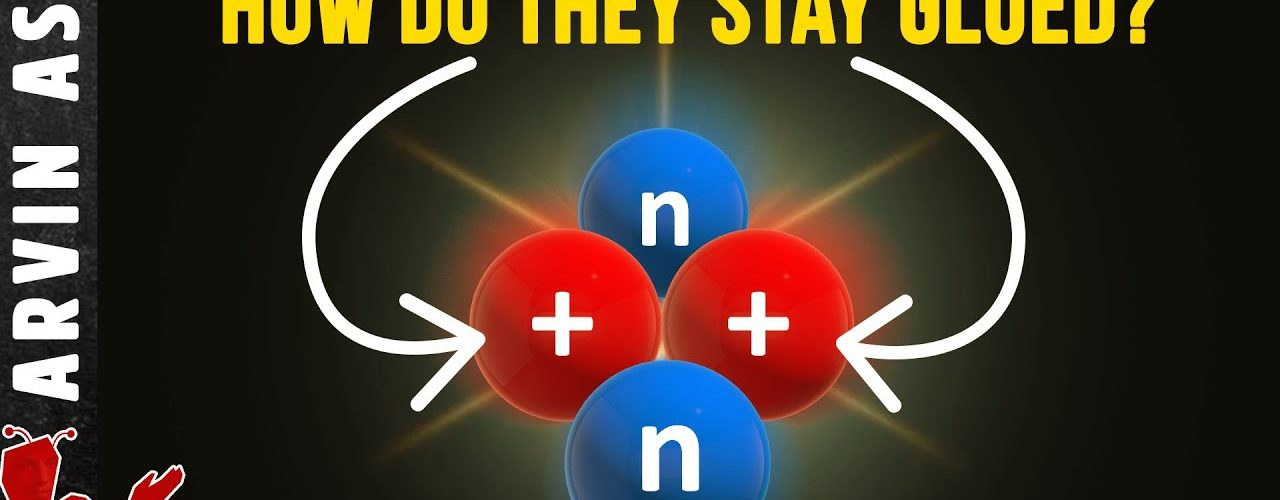Visit https://brilliant.org/arvinash/ to get started learning STEM for free, and the first 200 people will get 20% off their annual premium subscription.
Prior Video explaining the evolution of QCD:
SUMMARY:
Since electromagnetism is so strong, multiple protons in the nucleus of any atom like Helium should repel each other very strongly. So how do they stay glued together?…Because of a force that is even stronger than electromagnetism – 100x stronger, the Strong Nuclear Force.
This force is actually a RESIDUAL form of the strong force, and works via a different mechanism than the force keeping quarks inside nucleons. I review the science of quantum chromodynamics. This force not only keeps protons glued together, it is also responsible for 99% of the mass of objects. Only about 1% of the mass of objects come from the Higgs Field.
Protons and neutrons are made of quarks and gluons. A proton is made of two Up quarks and one down quark. A neutron is made of two down quarks and one up quark. Gluons within these nucleons are virtual particles so the number fluctuates, but there are 8 different types of Gluons which bind quarks together.
Both the quarks and gluons carry a color charge. It is analogous to an electric charge but works via a completely different mechanism, and it has nothing to do with optical colors. It is just a metaphor for a kind of charge property that quarks and gluons carry.
There are three kinds of color charges, red, green and blue, which combine to make a neutral charge. So just like electrical charges are conserved – positive with negative to make neutral, color charge is also conserved by either a combination of the three colors to make neutrol, or by color-anticolor pairs. There are anti-colors too.
Gluons bind quarks together by constantly exchanging color charge between them. This exchange occurs continuously. The constant exchange of gluons creates a kind of continuous bridge between quarks called a flux tube.
Electromagnetism, like gravity gets weaker as objects get farther apart. But the force between two quarks actually gets stronger as they get further apart. It works like a rubber band or spring. If you try to pull two quarks apart, the force between them gets stronger the further apart they are. This tends to pull a quarks back into the proton or neutron. However, if the quarks get too far apart, then the rubber band breaks.
When this break occurs, the energy required to break the rubber band creates a new quark and anti-quark pair, called a meson. This is called confinement in quantum chromodynamics because you cannot have free quarks. They are always confined together with at least one other quark. The newly created meson from the breaking of the rubber band is the key to how protons are kept glued together with other protons and neutrons in the nucleus.
What causes the quark-gluon flux tube to break and create a Meson? Although the color charges of quarks within nucleons combine to form a neutral color, such that the net color charge cancels out, quantum fluctuations ensure that this cancelation does not happen perfectly. This is especially true when nucleons are very close together.
Some color charge remains. This imperfect balance of color charge causes a residual strong force between nucleons.
This is called the strong nuclear force. It is mediated not by gluons, but by the exchange of mesons between two nucleons. It is the exchange of mesons between protons and neutrons that results in a residual strong force, also called the strong nuclear force, that keeps these nucleons tightly glued together.
This is a critical interaction because without it, there would be no atoms heavier than hydrogen because 2 protons could not bind together in the nucleus. And life as we know it would not exist.
#strongnuclearforce
#quantumchromodynamics
#QCD
It is called the strong nuclear force. But note that this is distinct from the strong force which works within the nucleons keeping the quarks tightly bound together. The latter is mediated by gluons. But the strong nuclear force is mediated by mesons. Although the strong nuclear force is much weaker than the strong force keeping quarks tied together in nucleons, it is still much stronger than the electromagnetic repulsive force between two protons. So protons are still glued together even though they feel a strong repulsive electromagnetic repulsion.
CHAPTERS:
0:00 The enormous force of electromagnetism
2:18 The particles involved in the strong force
3:59 The mechanism of the Color Charge
6:24 Confinement & how virtual mesons are formed
7:45 What causes flux tube to break?
8:47 Details of quark interactions between nucleons
12:20 Difference between Strong Force & Strong Nuclear Force
14:18 How to learn the fundamentals







